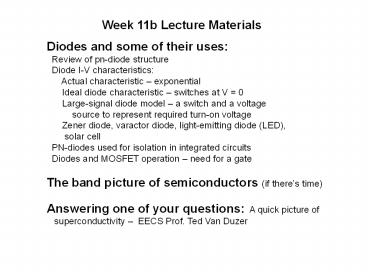Week 11b Lecture Materials - PowerPoint PPT Presentation
Title:
Week 11b Lecture Materials
Description:
superconductivity EECS Prof. Ted ... so that negligible carriers flow across the junction Ideal Diode Model of pn Diode Large-Signal Diode Model Application ... – PowerPoint PPT presentation
Number of Views:92
Avg rating:3.0/5.0
Title: Week 11b Lecture Materials
1
Week 11b Lecture Materials
Diodes and some of their uses Review of
pn-diode structure Diode I-V characteristics
Actual characteristic exponential
Ideal diode characteristic switches at V 0
Large-signal diode model a switch and a
voltage source to represent required
turn-on voltage Zener diode, varactor
diode, light-emitting diode (LED), solar
cell PN-diodes used for isolation in integrated
circuits Diodes and MOSFET operation need for
a gate The band picture of semiconductors (if
theres time) Answering one of your questions
A quick picture of superconductivity EECS
Prof. Ted Van Duzer
2
The pn Junction Diode
Schematic diagram
Circuit symbol
ID
p-type n-type
net donor concentration ND
net acceptor concentration NA
VD
cross-sectional area AD
Physical structure (an example)
ID
VD
metal
SiO2
SiO2
p-type Si
For simplicity, assume that the doping profile
changes abruptly at the junction.
n-type Si
metal
3
Water Model of Diode Rectifier
Simplistic view of why a pn-diode conducts
differently in forward and reverse bias When
the p side is made positive with respect to the n
side (forward bias), the positively charged holes
move toward the negatively charged electrons, and
they recombine. Then more carriers flow in from
the contacts. In reverse bias, the holes and the
electrons move away from each other, leaving no
mobile carriers in the middle hence, the diode
has an insulator in its middle region and no
current flows through.
Simplistic
4
Summary pn-Junction Diode I-V
- Under forward bias, current increases
exponentially with increasing forward bias - Under reverse bias, a potential barrier in the
middle of the junction is increased, so that
negligible carriers flow across the junction
The net result is an I-V curve that looks like
this, with typically nA currents in the reverse
direction (VD lt 0), and mA or more in the
forward direction (VD gt 0)
0.7 V for Si
5
Ideal Diode Model of pn Diode
Circuit symbol
I-V characteristic
Switch model
ID (A)
ID
ID
VD
VD
forward bias
reverse bias
VD (V)
- An ideal diode passes current only in one
direction. - An ideal diode has the following properties
- when ID gt 0, VD 0
- when VD lt 0, ID 0
- Diode behaves like a switch
- closed in forward bias mode
- open in reverse bias mode
6
Large-Signal Diode Model
Circuit symbol
I-V characteristic
Switch model
ID (A)
ID
ID
VD
VD
?
Vturn-on
forward bias
reverse bias
VD (V)
Vturn-on
For a Si pn diode, Vturn-on ? 0.7 V
RULE 1 When ID gt 0, VD Vturn-on RULE 2 When
VD lt Vturn-on, ID 0
- Diode behaves like a voltage source in series
with a switch - closed in forward bias mode
- open in reverse bias mode
7
Application Example Rectification using the
ideal diode
model
vs(t)
vR(t)
?
vs(t)
C
R
t
vR(t)
t
8
To get a really steady voltage out we can add an
integrated circuit regulator to the circuit.
9
Potential plots for forward- and reverse-biased
diodes in series with
a voltage source and a resistor
10
Clipping circuit using a pn-diode
11
One uses the reverse-bias breakdown voltage as a
voltage reference in
some circuits
12
Varactor diode
Light-emitting diode (LED)
13
Solar cells two designs
14
Solar cell with load and its I-V characteristic
15
Why are pn Junctions Important for ICs?
- The basic building block in digital ICs is the
MOS transistor, whose structure contains
reverse-biased diodes. - pn junctions are important for electrical
isolation of transistors located next to each
other at the surface of a Si wafer. - The junction capacitance of these diodes can
limit the performance (operating speed) of
digital circuits
16
Device Isolation using pn Junctions
a
b
No current flows if voltages are applied between
n-type regions, because two pn junctions are
back-to-back
b
a
gt n-type regions isolated in p-type substrate
and vice versa
17
Transistor A
Transistor B
p-type Si
We can build large circuits consisting of many
transistors without worrying about current flow
between devices. The p-n junctions isolate the
transistors because there is always at least one
reverse-biased p-n junction in every potential
current path.































